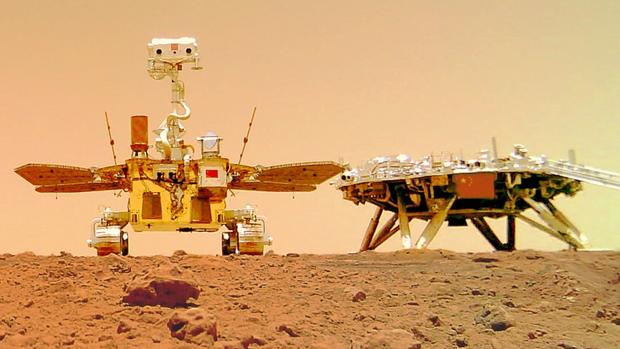Temporary change in planetary positions will affect communication from rover
 This photo released on June 11 by the China National Space Administration shows China’s first Mars rover Zhurong with the landing platform. (PHOTO PROVIDED TO CHINA DAILY)
This photo released on June 11 by the China National Space Administration shows China’s first Mars rover Zhurong with the landing platform. (PHOTO PROVIDED TO CHINA DAILY)
China's Tianwen 1 Mars mission will be inactivated for about 50 days from mid-September due to an expected disruption of its communications with Earth caused by solar electromagnetic radiation, the mission's chief designer said.
During the period, which will end in early November, the Zhurong rover and the mission's orbiter will suspend their working mode, Zhang Rongqiao of the China National Space Administration told reporters on Monday. The rover had been operating on the Red Planet for 100 days as of Monday, while the orbiter has been circling Mars since February.
"During that time, the Earth, Mars and the sun will almost be in a straight line and the distance between Earth and Mars will be farthest," Zhang said. "The sun's electromagnetic radiation will greatly affect the communication between the rover, the orbiter and ground control."
After they resume operation, the rover will continue traveling southward toward an ancient coastal area on Utopia Planitia, a large plain within the largest known impact basin in the solar system, for scientific exploration while the orbiter will enter a new Mars orbit to carry out a remote-sensing global survey of the Red Planet and will continue relaying signals between Zhurong and Earth, Zhang said.
As of Monday, Zhurong had traveled 1,064 meters on the Martian surface and was in good condition with sufficient energy, Zhang said.
The core component of the Tianwen 1 mission, the country's first interplanetary adventure, the 240-kilogram Zhurong has outlived its three-month life expectancy with all of its predetermined tasks completed.
The 1.85-meter-tall rover, which is now about 392 million kilometers from Earth, is the sixth rover on Mars, following five others launched by the United States.
Tianwen 1, named after an ancient Chinese poem, was launched on July 23 last year from the Wenchang Space Launch Center in Hainan province and traveled more than 470 million km and carried out several trajectory maneuvers before entering Martian orbit on Feb 10. Zhurong touched down on the planet on May 15 and separated from its landing platform a week later.
The mission has generated more than 420 gigabytes of primary data, with Zhurong alone having obtained about 10 GB of primary data, according to sources at the space administration.
To mark the mission's achievement, the administration and the People's Bank of China issued a set of gold and silver commemorative coins on Monday.



